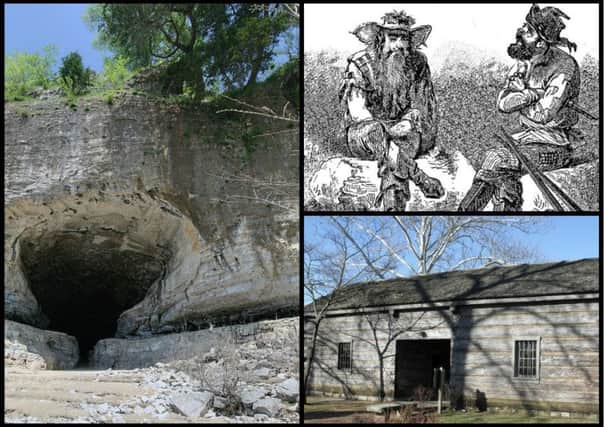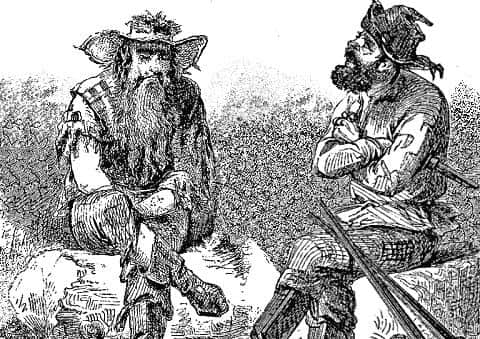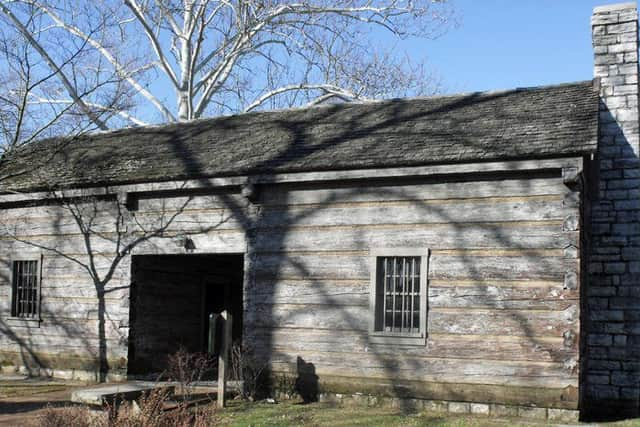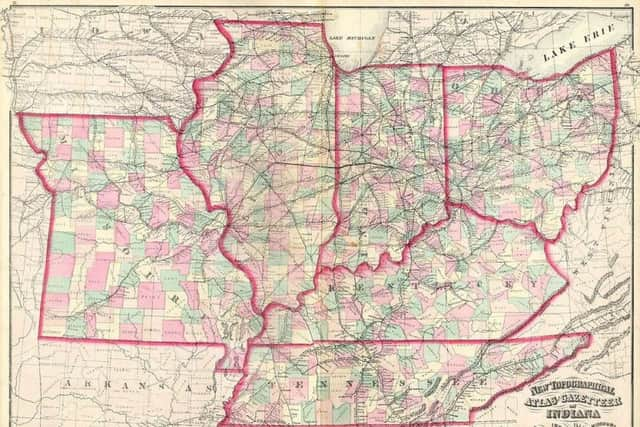The Harpe Brothers: Scots who became USA's first serial killers


Micajah and Wiley Harpe’s violent murder sprees - which included numerous children and infants - landed them the dubious distinction of being the United State’s first recorded serial killers.
The chilling details of their blood-soaked trail of death and destruction are still being dissected more than 200 years later.
Advertisement
Hide AdThe precise origins of the Harpe Brothers are sketchy. However, we do know Micajah and Wiley, born as Joshua and William, were cousins not brothers.


Their fathers left the Scottish west coast for America around 1760 and settled in Orange County, North Carolina.
Being first generation Scottish immigrants and staunch Tories, the Harpers were loyal to the British crown. The family changed their name to Harpe in an effort to curry favour with their patriot neighbours.
But it was not to be. Tensions rose as the American Revolutionary War approached.


Still children at the time, the Harpe Brothers watched from afar as their parents were brutally tortured and hanged for their loyalist affiliations.
This devastating personal tragedy would leave the orphaned Harpes dangerously embittered with the world and set them on a path of gratuitous butchery and depravity.
Illinois historian Jon Musgrave concurs with this notion.
Advertisement
Hide Ad“I think they realised early in they were not part of the elect and decided if they were going to hell they might as well make a grand entrance,” he said.


“The viciousness of the all but civil war in the Carolinas during the American Revolution didn’t help and certainly led them away to the wilderness and the less than civilised norms they lived over the next couple of decades.”
Advertisement
Hide AdDescribed as “bony and muscular”, Micajah “Big” was the brawn to the red-haired Wiley “Little” Harpe’s brains, but both shared a penchant for carrying out unspeakable atrocities.
During the American War of Independence the Harpes were part of a Tory rape gang who took advantage of wartime lawlessness to wreak havoc across the American patriot communities of North Carolina.


The Harpes were part of a posse responsible for the kidnapping and rape of three teenage girls. Little Harpe attempted to rape a fourth girl but was shot and wounded by Captain James Wood of the US Continental Army.
After spending some time with the Cherokee Indians in the early 1780s, with whom they developed a fondness for the tomahawk, the Harpes kidnapped two women: Maria Davidson and Susan Wood, Captain Wood’s daughter. Twice their horrifically abused captives bore children, the Harpe Brothers murdering the infants on each occasion.
Around 1795, the Harpes made efforts to make a life for themselves and relocated to a farm outside Knoxville Tennessee. Wiley married a minister’s daughter named Sarah Rice, while Micajah helped himself to sisters Susan and Betsy Roberts. Similar to Davidson and Wood before them, some believe these women were kidnapped, beaten and forced to marry against their will.
Unsurprisingly, the Harpes’ attempts at peaceful country living didn’t last.
Advertisement
Hide AdBefore long, their neighbours sussed out that the pair were pilfering their livestock. In 1798 the Harpes were duly charged and forced out of town.
In retaliation, the Harpes murdered a man named Johnson who they believed was one of their accusers. Thus began a bloody 18-month-long killing spree.


Advertisement
Hide AdJohnson’s mutilated body was found floating in the Holstein River, his chest cavity ripped open and filled with rocks. The grim manner of the killing would prove to be a regular Harpe Brothers’ calling card.
While on the move, the Harpes killed twice more. The latter involved a young gentleman named John Langford who had been foolhardy enough to travel solo in the wilderness with a purse full of silver. Again, the body was discovered in typically gruesome fashion, but this time the authorities figured out who the culprits were. In December 1799 the Harpes and their women were captured and taken to a prison cell in Danville, Kentucky.
Two months into their prison stay, the Harpes managed to make a daring escape, deserting their three heavily-pregnant wives in the process.
From here the Brothers, each of whom had a $300 bounty placed on his head, made their way to the Samson Mason Gang’s notorious Cave-in-Rock stronghold at Illinois. En route, they continued to satisfy their bloodlust and took the lives of numerous people, including a 13-year-old boy.
At Cave-in-Rock, the Harpes joined Mason’s river pirates in the lucrative business of raiding merchant flatboats travelling downstream on the Ohio River.
Murderous as the pirates were, they couldn’t stomach the Harpe Brothers’ execrable habit of stripping victims naked before tying them to a blindfolded horse and running it off the top of the bluff. In May 1799 the Micajah and Wiley, plus their women and infant children (who were back together having been acquitted of their husband’s crimes) were given their marching orders.
Advertisement
Hide AdSome question why the Harpes’ wives would possibly want to reunite with their exceptionally unstable husbands.
“I think the Harpe “wives” were brutalized battered women trying to survive and protect whatever children they could,” says Jon Musgrave.
Advertisement
Hide Ad“During the early part of 1799 when the Harpes were barely midway in the killing spree all three were pregnant or had just given birth. They had no way to survive apart from the men, not in the wilderness with news of food and shelter when caring for infant children. That’s even if they thought they could get away without being tracked down and killed by their husbands.”
The Harpes travelled hundreds of miles on foot through Kentucky and Tennessee, notching up several more victims: William Ballard’s disembowelled corpse was discovered drifting down the Holston River; James Brassel had his throat hacked open; John Graves and his teenage boy were found decapitated; while in Logan County, the brothers murdered a young slave girl and a family that lay fast asleep at their camp.
Jon Musgrave explains how the American wildnerness played a part in enabling the Harpes to carry out one murder after another: “The near wilderness frontier west of the Appalachians and the sparsity of settlements allowed the Harpes maximum freedom to commit their depravations.
“Kentucky and Tennessee were states - young but at least formally organized, but when they crossed north of the Ohio River at Cave-in-Rock they were in the old Northwest Territory where the nearest lawman was more than 100 miles away.
“We’ve had a few killers with larger death tolls but generally they were drifters and no one knew about them until they got caught and convicted for one or two and then started confessing to others.”
Summer 1799 witnessed a new low, when, irritated by his baby daughter’s persistent screaming, Big Harpe grabbed the infant by the legs and smashed her head into a tree. He later stated it was the only time he regretted a murder.
Advertisement
Hide AdIn late August the Harpes sought shelter at a farmstead in Webster County, Kentucky. They stayed overnight at the behest of a Mrs Stegall, who would pay for her act of kindness.
The despicable pair slit the throat of Mrs Stegall’s four-month-old baby boy and murdered her too when she discovered the body.
Advertisement
Hide AdWhen Mr Stegall, who had been away at the time of his family’s murders, returned he and a posse set about tracking the Harpes down. When they successfully caught up with Big Harpe, they shot him in the back, before Stegall took a blade and slowly sawed off his head starting at the back of his neck.
Little Harpe lived to kill another day, rejoining the river pirates at Cave-in-Rock. His luck would eventually run out after he and another man double-crossed Captain Mason and attempted to take his head in for a handsome reward. The authorities recognised the flame-haired felon and had his head chopped off.
And so came to an end the lives of the most dangerous and brutal killers on the American frontier. It is estimated that the Harpe Brothers killed as many as fifty people, though the true figure will never be known.
In hindsight the Harpes’ capture was inevitable. They never appeared to have a clear motive to kill, other than to erase those who angered them or got in their way.
“I don’t think the Harpes had an end game, other than to stay alive as long as they could,” muses Jon Musgrave.
“According to Judge Hall, who was one of the first to write about the Harpes in the 1820s, there were two types of men on the frontier. The first was the noble pioneer seeking to do right by his family and God. The second wasn’t looking to advance civilization. He was trying to escape it. They were men, as Hall put it, with a blunt perception of virtue.
Advertisement
Hide Ad“They were just human and capable of the same level of evil as anyone. Though if there ever was a figure of American history demonically possessed, Big Harpe would be at top of my list.
“The Harpes were able to strike fear while they were living and then became ‘The boogeymen’ for generations to come.”
• Jon Musgrave is an Illinois historian author and screenwriter who runs IllinoisHistory.com.